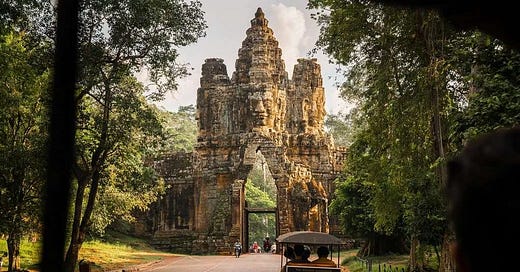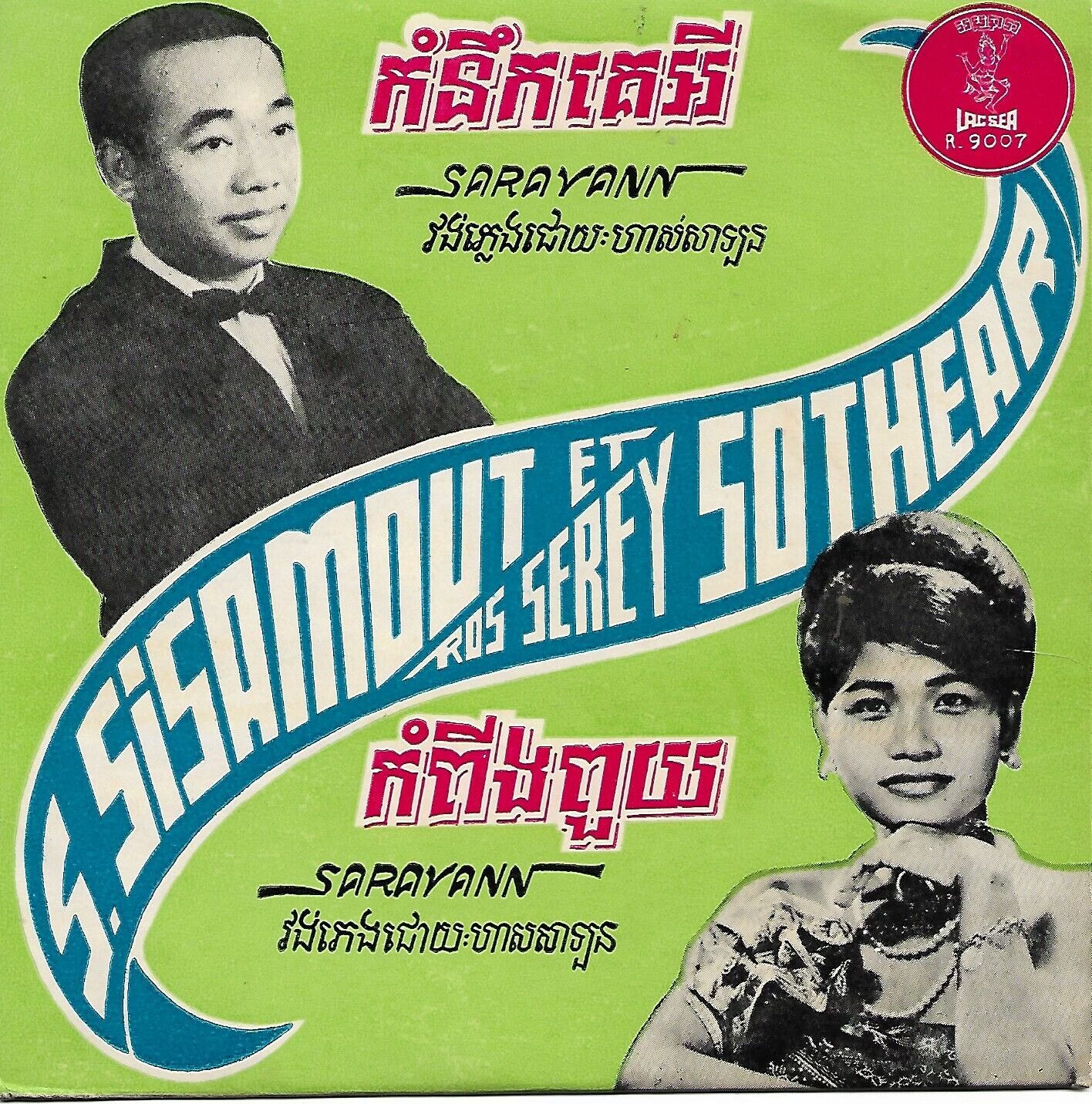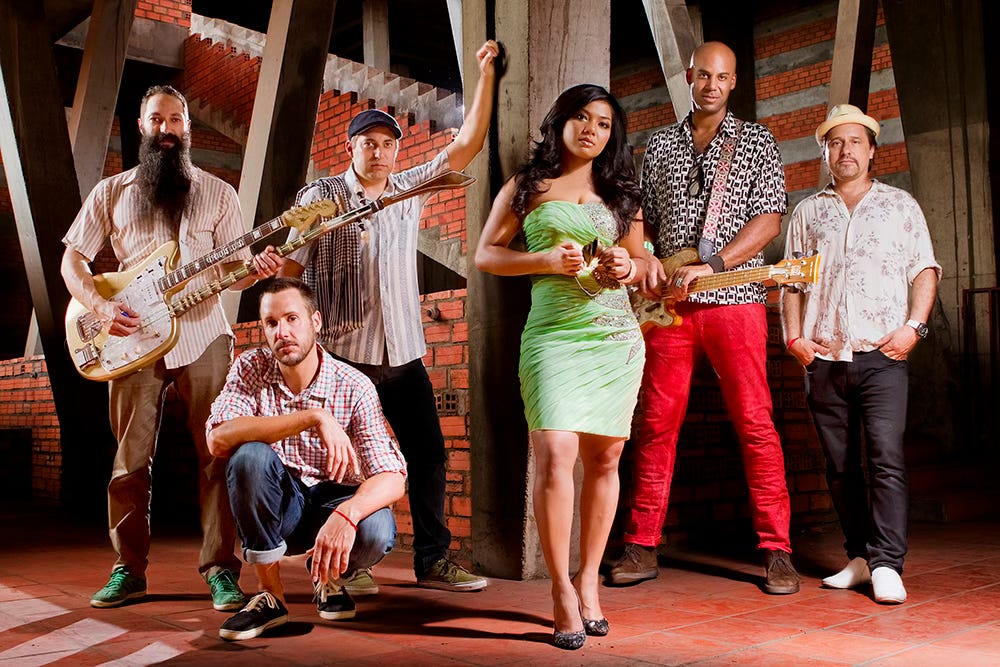Cambodian Rocks & Dengue Fever
An amazing true story that began with a tourist bringing home mixtapes
The origins of the mysterious Cambodian Rocks album, and the band Dengue Fever. A version of this story is sourced on Wikipedia, and first appeared in American Way magazine in 2009.
In 1994, an American named Paul Wheeler traveled to Cambodia to visit the temples of Angkor Wat. As he hung out in the neighboring town of Siem Reap, he kept hearing amazing rock music played in the restaurants. It was familiar yet totally unfamiliar—a cool mix of ’60s garage guitar rock, pop tunes, and surf instrumentals, professionally recorded, with vocals sung in the Khmer language. And it rocked.
“I hired a guy on a motorcycle to take me to a place where I could buy some Cambodian music,” remembers Wheeler. “He drove me to a market where there was a guy set up and selling cassette tapes. I had him play me various stuff for an hour or two, and ended up buying about six tapes from him.”
Wheeler compiled a mixtape of his favorite songs, and upon returning to the U.S., he played the tape for a friend who owned Parallel World, a small re-issues record label based in New York City.
“He loved it as much as I did, and suggested putting out some of it on his label,” says Wheeler. “It was released first as a limited pressing record of 1,000.”
The vinyl album Cambodian Rocks featured cover art of a charcoal rubbing taken from an Angkor War temple bas-relief. There were no liner notes or any information about any of the songs. But some of the music was vaguely recognizable, peculiar go-go organ and fuzz-guitar versions of “Gloria,” “Hip Hug-Her” by Booker T and the MGs, and something that sounded an awful lot like “Black Magic Woman.”
The record immediately sold out, and Parallel Records released a longer version on CD. More of the music appeared on other labels, and America’s hipster underground kicked into high gear, with campus radio playing the music, people trading tapes, and zines writing up reviews. Nobody understood the lyrics, but it sounded fun, and specific, and it rocked. Whoever it was.
A few years later, Los Angeles musician Ethan Holtzman and a friend traveled to Siem Reap. His buddy was bitten by a mosquito and contracted dengue fever, and travel plans changed—the two hopped on a truck to a hospital. As they bounced along a bumpy dirt road, Ethan heard this strange music playing on the truck’s radio. To his ears, it sounded like an evocative blend of ’60s psychedelia, surf, and British Invasion, influenced by Western rock and roll which had filtered into Southeast Asia during the Vietnam War.
As Paul Wheeler had done a few years earlier, Ethan collected some of the music cassettes and returned to L.A. He met with his brother Zac Holtzman, also a musician and former member of the San Francisco band Dieselhed. Both realized by total coincidence, they had been listening to the same songs. They learned that during the Khmer Rouge genocide of the 1970s, Pol Pot singled out Cambodia’s artists and musicians for execution. The people who made this music were most likely dead.
Eventually the musicians would be identified, and listeners would finally know their names. Pop singers like Pan Ron, and Ros Serey Sothea, “the queen of Cambodian rock ‘n’ roll,” and singer-songwriter Sinn Sisamouth, known as “the Cambodian Elvis.”
“We started talking about what a shame it was that all these really great, cool artists were killed while they were just doing what they wanted to do,” Zac Holtzman recalls. “We thought it was a good idea to pick up the ball where they left off.”
The Holtzman brothers began putting together a band to resurrect Cambodian rock and roll. They chose the name Dengue Fever as a tongue-in-cheek ode to Ethan’s truck ride. The two hung out in Long Beach nightclubs populated by Cambodian refugees, and after auditions, found vocalist Chhom Nimol, a recent transplant and onetime Cambodian pop star, who had come from a prominent musical family.
Things clicked immediately despite the language differences, and Dengue has since released three CDs, mixing Cambodian Rocks tunes among their own compositions. The band adds its own tinges of jazz and sci-fi/spaghetti-western texture, beefing up the arrangements with Ethan’s nuanced Farfisa organ and Dave Ralicke’s killer horn parts, all fronted by Nimol’s stage presence and amazing vocal fluidity. Their atmospheric sound proves a natural fit for many soundtracks, including Matt Dillon’s City of Ghosts, Jim Jarmusch’s Broken Flowers, and episodes of Weeds.
Dengue Fever has spent the last few years touring the world, and in 2005 they traveled back to Cambodia, a trip captured in the 2009 DVD documentary, Sleepwalking Through the Mekong. Cambodians were wildly curious about what had happened to Nimol, who had left for the U.S. some years before.
“Everyone was really happy that she didn’t come back all totally Hollywood and Americanized,” says Zac. “She came back with her old traditional music, with us backing her up. Everyone was happy about that. It made them feel proud about their culture.”
Dengue is often asked whether they play world music, or indie rock, and the short answer is both. No longer defined by Putamayo albums played in restaurants, world/international music is now being pushed in all directions, from the pioneering Ry Cooder, to the multicultural Manu Chao and the Amazonian-flavored Chicha Libre, who often tours with Dengue Fever.
“It’s cool to see this indie rock scene being more open to all the different ethnicities and cultures around the world,” says Zac Holtzman. “And it’s cool for the world music scene to not only be Guatemalan baggy pants and steel drums.”
Dengue Fever released their newest album Ting Mong in 2023. Their tour comes to Long Beach and San Francisco next month.






Great to hear all this history. Great piece! Mix tapes opened so many ears in so many ways. Here is a theatrical descendant the also rocks. https://g.co/kgs/XCRRbcmCambodian Rock Band